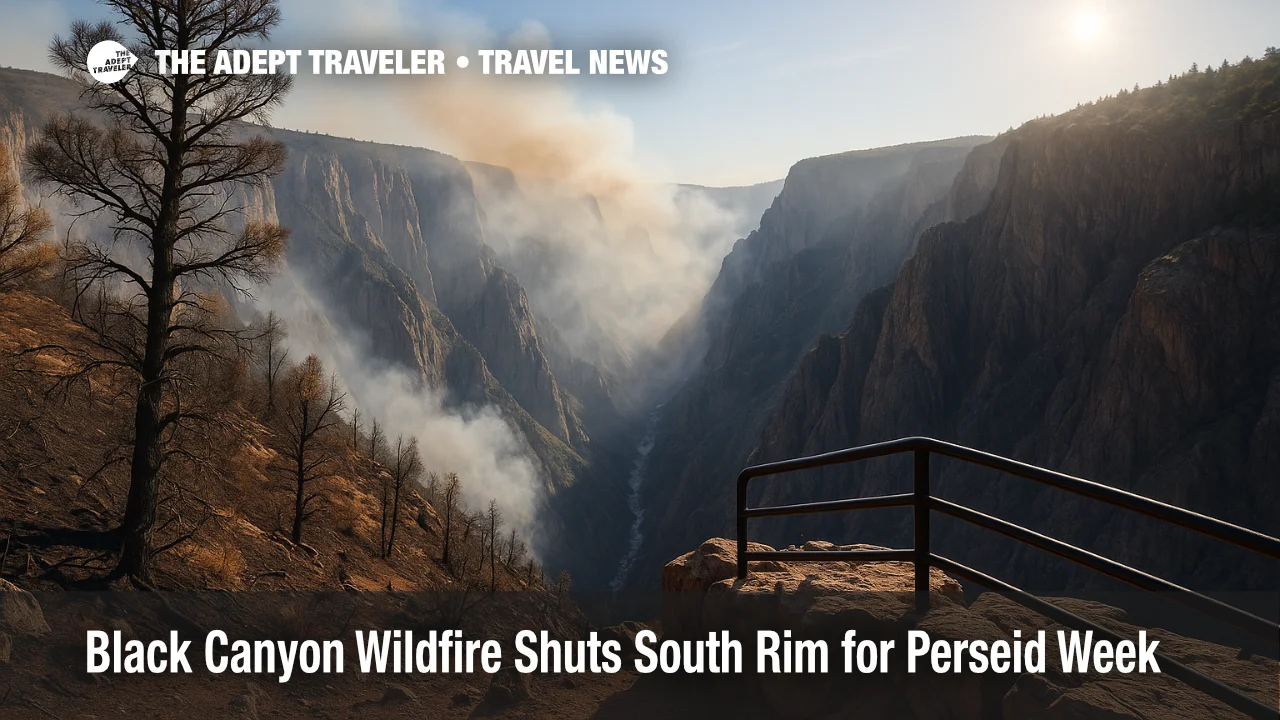Black Canyon wildfire shuts South Rim for Perseid week

Black Canyon of the Gunnison National Park in western Colorado has sealed its South Rim and East Portal roads as a 4,220 acre lightning sparked blaze continues to smolder less than a mile from popular overlooks. Fire managers say containment, stalled near 40 percent since Friday, may dip when gusty southerlies arrive early next week, potentially keeping the park's signature rim drives closed through the August 11-13 Perseid meteor peak that draws hundreds of amateur astronomers.
Key Points
- Why it matters: The South Rim holds the park's visitor center, main overlooks, and its largest campground.
- Travel impact: South Rim Drive and East Portal Road remain closed; only the North Rim is open for day use and camping.
- What's next: Fire managers say containment could slip if forecast winds arrive before fresh crews rotate in mid-week.
- Lightning ignited on July 10, the South Rim Fire is 41 percent contained at 4 220 acres.
- Park staff warn the closure may last beyond the August 11-13 Perseid meteor-shower surge.
Snapshot
Black Canyon of the Gunnison National Park in western Colorado is facing its largest wildfire on record. The South Rim Fire, sparked by a July 10 lightning strike, has already consumed maintenance buildings, restroom blocks, and much of the South Rim Campground. With containment hovering near 40 percent, the National Park Service (NPS) has kept South Rim Drive, East Portal Road, and all associated trails off-limits. Only the North Rim reopened July 30 remains available, and services there are minimal. The timing is painful: summer visitors flock to the International Dark Sky Park each August for the Perseid meteors. Rangers now caution that popular night-sky programs will likely be canceled or shifted to nearby Curecanti National Recreation Area.
Background
Black Canyon's dizzying 2,000 foot cliffs funnel winds that can both fan and trap wildfire. Earlier prescribed burns were deferred after a wet 2024 spring left fine fuels untreated. When a monsoon pulse delivered dry lightning last month, the canyon's steep walls and dense juniper stands turned the initial half-acre start into a fast-moving crown fire. By July 12 the blaze had doubled twice, prompting a full evacuation of visitors and staff. Air attack teams have relied on water scooped from Blue Mesa Reservoir, while ground crews carve hand lines along the park's southern boundary to keep flames from Gunnison National Forest.
Latest Developments
How the Black Canyon wildfire is affecting peak stargazing season
The South Rim visitor center was meant to host three sold out Perseid programs beginning August 10. Those tickets are now refunded. Rangers tell would be sky watchers to head either 12 miles east to the Dillon Pinnacles Overlook at Curecanti-an equally dark site, or west toward Montrose's Owl Creek Pass pullouts. Flights into Montrose Regional Airport (MTJ) and Gunnison-Crested Butte Regional Airport (GUC) are running normally, but lodging near the park is tightening as travelers shift plans. Fire officials warn that gusty southerlies forecast for Tuesday could push embers down canyon, delaying any phased reopening until at least the middle of next week. A Type 3 incident team will rotate fresh firefighters onto the line tomorrow, bringing total personnel to about 260.
Analysis
The immediate closure underscores how a single lightning strike can ripple through regional tourism. Black Canyon welcomed more than 1.3 million visitors last year, and August alone accounted for nearly one fifth of that footfall, largely because of its renowned dark skies. Campground and concession losses will hit local economies in Montrose and Gunnison, where park travelers spent an estimated $25.6 million in 2024. For visitors, the lesson is clear: shoulder season trips carry growing wildfire risk across the Mountain West. Travelers should build flexible itineraries that include backup lodging in nearby towns, refundable activity bookings, and route options that avoid smoke impacted highways. The North Rim offers a limited fix, but its gravel access road and small campground mean capacity is capped at a fraction of normal South Rim crowds. If winds hold and containment improves, managers could open select overlooks late next week, yet even that will depend on structure assessments and hazard-tree removal. Until then, travelers chasing the Perseids will need to pivot.
Final Thoughts
Wildfire seasons are lengthening across Colorado, and the Black Canyon wildfire shows how quickly visitor plans can be upended. Build contingencies, monitor NPS alerts daily, and be ready to relocate your telescope-this year's Perseid memories may form under unfamiliar skies, but the meteors will still fly.
